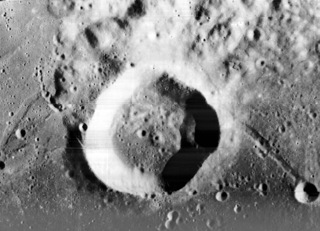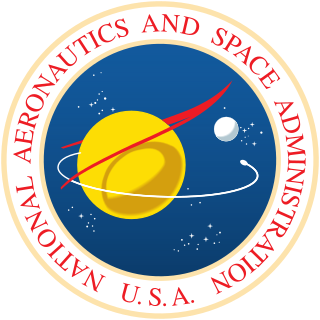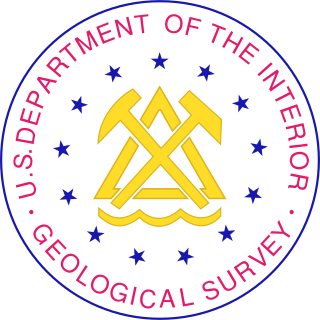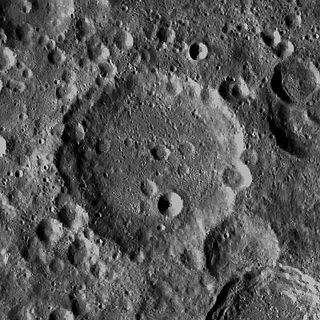
Anderson is a lunar impact crater that is located on the far side of the Moon. It is located to the northwest of the crater Sharonov, and the satellite crater Sharanov X is attached to the southeast rim of Anderson. To the northeast is the peculiar formation Buys-Ballot, and to the east-southeast lies the larger crater Spencer Jones.

Büsching is a lunar impact crater that is located in the crater-covered southern highlands of the Moon. It was named after German geographer Anton F. Büsching. The similar-sized crater Buch is located adjacent to its southwestern rim, and further to the southwest lies Maurolycus.

Chamberlin is a lunar impact crater that is located on the far side of the Moon, just past the southeastern limb. It lies to the southeast of the crater Jeans, and Moulton is attached to the southeastern rim of Chamberlin. This crater is located in a part of the lunar surface that has undergone resurfacing of crater interiors, producing dark-hued crater floors.

Bunsen is a lunar impact crater that lies near the northwestern limb of the Moon. It is located to the west of the Oceanus Procellarum and the crater von Braun. To the southeast is the crater Lavoisier, and to the northeast lies Gerard. Northwest of Bunsen, on the far side of the Moon, is McLaughlin. Due to its position this crater appears foreshortened when viewed from the Earth, and its visibility is affected by libration.

Blanchard is a lunar impact crater that lies on the far side of the Moon, just behind the southwestern limb. It lies to the south-southwest of the crater Arrhenius, and northwest of Pilâtre. Further to the south is the rugged terrain to the north of the walled plain Hausen.

Casatus is a lunar impact crater that is located near the southern limb of the Moon. The north-northeast rim of the crater overlies a portion of the slightly larger crater Klaproth. Along the western rim, Casatus A intrudes somewhat into the interior, producing an inward-bowing rim. To the southeast of Casatus is Newton.
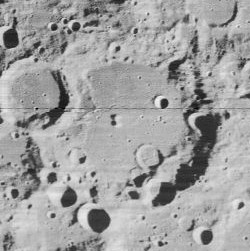
Volta is a lunar impact crater near the northwest limb of the Moon. It is located south-southeast of the crater Xenophanes, and due north of the smaller Galvani. The crater Regnault lies across the western rim of Volta. Attached to the southwest rim of Volta and the southern rim of Regnault is Stokes. Lying between Volta and Stokes in the north, and Galvani in the south, is the worn Langley.

Chebyshev is a large lunar impact crater that lies in the southern hemisphere on the far side of the Moon. The somewhat smaller crater Langmuir is intruding into the east-southeastern rim of Chebyshev, forming a chain of large craters with Brouwer on Langmuir's eastern rim.

Challis is a lunar impact crater that is located in the northern regions of the Moon's near side, close enough to the limb to appear significantly foreshortened when viewed from the Earth. It is joined to the crater Main through a break in the northern rim, and is close to Scoresby along the southeast side.

Clairaut is a lunar impact crater that is located in the rugged southern highlands of the Moon's near side. It lies directly to the south of the crater Maurolycus and southeast of Barocius. Just to the southwest is Cuvier.

Galvani is a lunar impact crater that lies close to the northwestern limb of the Moon, due south of the larger walled plain Volta. It partly overlies the southeast rim of the crater Langley, which occupies half the gap between Volta and Galvani. To the northeast is the large walled plain Repsold, and to the west-southwest, on the far side of the Moon, is the crater McLaughlin.
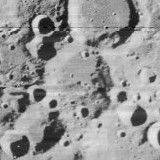
Stokes is a lunar impact crater that is nestled in the curve formed by the craters Regnault to the north, Volta along the northeast, and Langley. This formation of craters lies nearly along the northwestern limb of the Moon, where their visibility is affected by libration effects.
Dove is a small lunar impact crater that is located in the rugged lunar highlands in the southeastern part of the Moon. It lies to the north of the prominent crater Pitiscus.

Curie is a large lunar impact crater, much of which lies on the far side of the Moon as seen from the Earth. The western rim projects into the near side of the Moon, as defined by the selenographic coordinate system. However the visibility of this formation depends on the effects of libration, so that it can be brought fully into view or completely hidden depending on the orientation of the Moon. When visible, however, it is seen nearly from the side, limiting the amount of detail that can be observed.

Repsold is a lunar impact crater that is located at the western end of the Oceanus Procellarum. It lies to the northeast of the crater Galvani and southeast of the walled plain Volta. Due to its proximity to the northwestern limb of the Moon, this crater appears highly foreshortened when viewed from the Earth. It is named after Johann Georg Repsold, a German astronomer.

Fraunhofer is a lunar impact crater that is located just to the south-southwest of the walled plain Furnerius, in the southeastern part of the Moon. This crater appears foreshortened when viewed from the Earth, and is actually nearly circular.
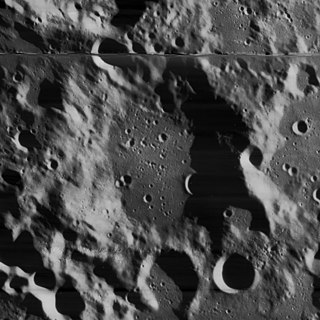
Wilson is a lunar impact crater that lies in the southern part of the Moon's near side, to the southwest of the large walled plain Clavius. It is nearly attached to the southeastern rim of the slightly larger crater Kircher. Almost due east lies Klaproth, another walled plain.

Douglass is a lunar impact crater on the far side of the Moon. It lies to the southwest of the crater Frost and south-southwest of the large walled plain Landau.

Donner is a lunar impact crater on the far side of the Moon. It is located just to the northeast of the Mare Australe, behind the southeastern limb of the Moon. During favorable librations this part of the lunar surface can be brought into view of the Earth, but the site is viewed from the edge and so not much detail can be seen.

Fridman is the remains of a lunar impact crater on the far side of the Moon. It lies due south of the huge walled plain Hertzsprung, and is attached to the northeastern rim of the crater Ioffe.

